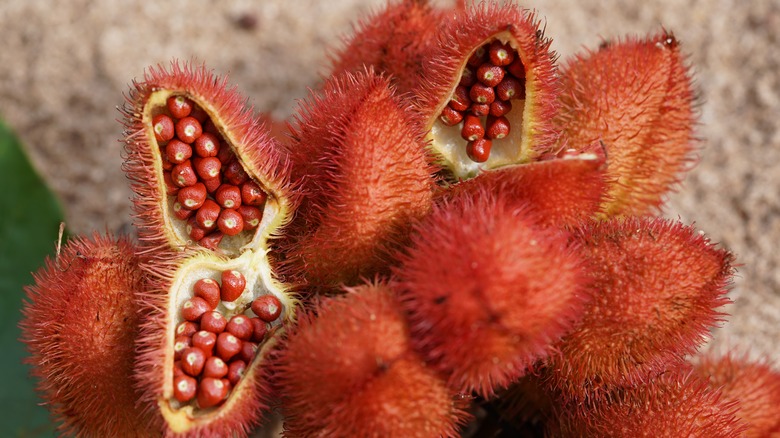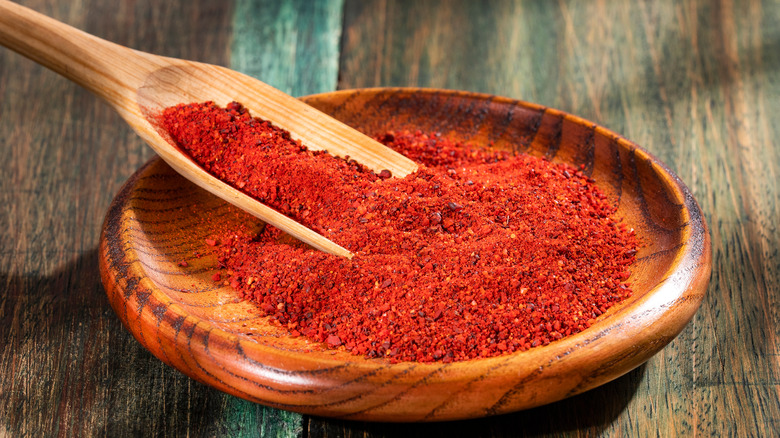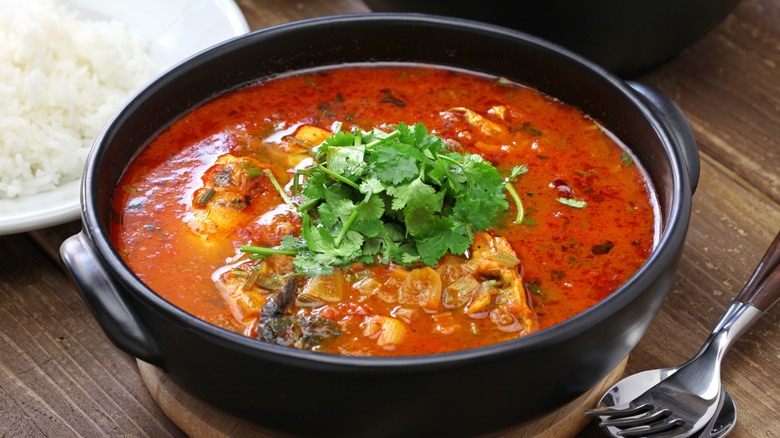Use Annatto Seeds To Give A Vibrant Boost To Beige Sauces
Bringing French influences into your kitchen can be as simple as mastering the country's culinary basics. Because of widespread use, the "five French mother sauces" reign supreme in chefs' arsenals — including creamy beige or white sauces such as béchamel, hollandaise, and velouté, explains MasterClass.
The important thing about the five mother sauces is the ability to add more ingredients, thereby creating countless other customized sauces to transform any dish. Depending on the recipe, light-colored sauces can benefit from color or flavor infusions, and that's where annatto seeds enter the picture.
The rich-red seeds come from achiote trees, which thrive in South and Central America, according to Healthline. They most commonly appear in ground powder, paste, or liquid forms when used for cooking, but some advocate using the seeds directly, which are typically available in dried form. Annatto also colorizes sauces across the globe, including those used in the Caribbean, Puerto Rico, Brazil, and other Latin American recipes.
Sauces transformed by annatto seeds
Annatto seeds impart a rosy hue to sauces as well as a hint of sweet, peppery flavor and a nut-forward floral aroma, notes Healthline. The color comes from the natural carotenoid pigments in the seeds, similar to tomatoes, carrots, pumpkins, and other red-orange vegetables. Annatto is the preferred food coloring for those who choose Mother Nature over other dyes or additives, accounting for as much as 70% of the natural food-color market. The seeds also harbor health-boosting antioxidants, antimicrobial, and potential anti-cancer properties, and may help with eye and heart health.
Incorporating annatto into light-colored sauces is easy if you purchase them in ground form or as a paste. The brilliant red hues in Mexican cooking often come from achiote paste, which is the Mexican name for annatto seeds, according to Chili Pepper Madness. You'll see and taste it in saucy dishes such as red Indian curries, Vietnamese soups, spicy tacos, Spanish rice casseroles, Brazilian stews, Filipino chicken inasol, stewed achiote beans, and countless other iterations, per Yummly.
Food & Wine explains that the neutral color of béchamel can be unappetizing on a bowl or plate, especially for young eaters, so steeping annatto seeds in the roux milk adds an easy explosion of color. Annatto can also be an affordable substitute for the very expensive saffron spice when making yellow rice or creamy desserts, explains Just a Pinch.
More annatto magic
Another way to infuse natural color into a sauce is by adding annatto as an oil. It's often available from grocery stores or smaller markets specializing in Mexican or Latin cooking. Annatto oil also commonly appears in Vietnamese or Filipino cuisine, explains Full of Plants. If it's not readily available where you live, you can make your own annatto oil at home with just three ingredients and about 15 minutes.
Start by frying dried whole annatto seeds in a neutral-tasting oil such as canola or grapeseed for up to three minutes, suggests Full of Plants. After removing from the pan, add a clove of crushed garlic if desired, let it cool, and then strain out the seeds and garlic. The resulting annatto oil is ready to tint sauces, curries, and marinades, bringing vibrant color and flavor to your dinner table any day of the week. You can also use the oil to make Vietnamese satay sauce, as demonstrated in a video from Boriville.
If all this has you wondering what other foods annatto is turning red, orange, or yellow, here are a few you may recognize: Velveeta and cheddar cheese, butter, mustard, custard, Goldfish crackers, Cheetos, bottled Cajun seasonings, lemon-flavored cookies, notes Verywell Health. So if you're looking for an all-natural way to add vibrant color to a dish, try out annatto seeds.


